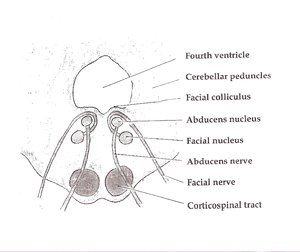Lateral pontine syndrome
A lateral pontine syndrome is a lesion which is similar to the lateral medullary syndrome, but because it occurs in the pons, it also involves the cranial nerve nuclei of the pons.
| Lateral pontine syndrome | |
|---|---|
 | |
| Pons | |
| Specialty | Neurology |
Symptoms
Damage to the following areas produces symptoms (from medial to lateral):
| Structure affected | Effect |
|---|---|
| Lateral spinothalamic tract | Contralateral loss of pain and temperature from the trunk and extremities. |
| Facial nucleus & facial Nerve (CN.VII) | (1) Ipsilateral paralysis of the upper and lower face (lower motor neuron lesion). (2) Ipsilateral loss of lacrimation and reduced salivation. (3) Ipsilateral loss of taste from the anterior two-thirds of the tongue. (4) Loss of corneal reflex (efferent limb). |
| Spinal trigeminal nucleus and tract | Ipsilateral loss of pain and temperature sensation from the face (facial hemianesthesia) |
| Vestibular Nuclei and intraaxial nerve fibers | Nystagmus, nausea, vomiting, and vertigo |
| Cochlear nuclei and intraaxial nerve fibers | Hearing loss - ipsilateral central deafness |
| Middle & inferior cerebellar peduncle | Ipsilateral limb and gait ataxia |
| Descending sympathetic tract | Ipsilateral Horner's syndrome (ptosis, miosis, & anhydrosis) |
Causes
It can be caused by an interruption to the blood supply of the anterior inferior cerebellar artery or circumferential arteries.[1]
Diagnosis
Treatment
References
- Campbell, William W. (2012). DeJong's The Neurologic Examination. Lippincott, Williams & Wilkins. p. 338. ISBN 9781469817521.
This article is issued from
Wikipedia.
The text is licensed under Creative
Commons - Attribution - Sharealike.
Additional terms may apply for the media files.